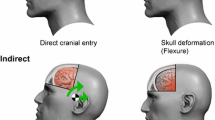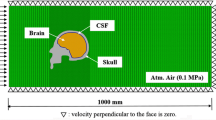Abstract
Studies on blast neurotrauma have focused on investigating the effects of exposure to free-field blast representing the simplest form of blast threat scenario without considering any reflecting surfaces. However, in reality personnel are often located within enclosures or nearby reflecting walls causing a complex blast environment, that is, involving shock reflections and/or compound waves from different directions. The purpose of this study was to design a complex wave testing system and perform a preliminary investigation of the intracranial pressure (ICP) response of rats exposed to a complex blast wave environment (CBWE). The effects of head orientation in the same environment were also explored. Furthermore, since it is hypothesized that exposure to a CBWE would be more injurious as compared to a free-field blast wave environment (FFBWE), a histological comparison of hippocampal injury (cleaved caspase-3 and glial fibrillary acidic protein (GFAP)) was conducted in both environments. Results demonstrated that, regardless of orientation, peak ICP values were significantly elevated over the peak static air overpressure. Qualitative differences could be noticed compared to the ICP response in rats exposed to simulated FFBWE. In the CBWE scenario, after the initial loading the skull/brain system was not allowed to return to rest and was loaded again reaching high ICP values. Furthermore, results indicated consistent and distinct ICP-time profiles according to orientation, as well as distinctive values of impulse associated with each orientation. Histologically, cleaved caspase-3 positive cells were significantly increased in the CBWE as compared to the FFBWE. Overall, these findings suggest that the geometry of the skull and the way sutures are distributed in the rats are responsible for the difference in the stresses observed. Moreover, this increase stress contributes to correlation of increased injury in the CBWE.











Similar content being viewed by others
References
Abdul-Muneeret, P. M., H. Schuetz, F. Wang, M. Skotak, J. Jones, S. Gotantla, M. C. Zimmerman, N. Chandra, and J. Haorah. Induction of oxidative and nitrosative damage leads to cerebrovascular inflammation in animal model of mild traumatic brain injury induced by primary blast. Free Radic. Biol. Med. 2013. doi:10.1016/j.freeradbiomed.2013.02.029.
Bauman, R. A., G. Ling, L. Tong, A. Januszkiewicz, D. Agoston, N. Delanerolle, Y. Kim, D. Ritzel, R. Bell, J. Ecklund, R. Armonda, F. Bandak, and S. Parks. An introductory characterization of a combat-casualty-care relevant swine model of closed head injury resulting from exposure to explosive blast. J. Neurotrauma 26:841–860, 2009.
Bolander, R., B. Mathie, C. Bir, D. Ritzel, and P. VandeVord. Skull flexure as a contributing factor in the mechanism of injury in the rat when exposed to a shock wave. Ann. Biomed. Eng. 39(10):2550–2559, 2011.
Bolander, R. A Multi-Species Analysis of Biomechanical Responses of the Head to a Shock Wave, Detroit, Wayne State University Dissertations, 2012.
Bowen, I. G., E. R. Fletcher, and D. R. Richmond. Estimate of man’s tolerance to the direct effects of air blast. Tech. Report DASA 2113. Washington, DC: Defense Atomic Support Agency, pp. 1–44, 1968.
Cernak, I., A. Merkle, V. Koliatsos, J. Bilik, Q. Luong, T. Mahota, L. Xu, N. Slack, D. Windle, and F. Ahmed. The pathobiology of blast injuries and blast-induced neurotrauma as identified using a new experimental model of injury in mice. Neurobiol. Dis. 41:538–551, 2011.
Cernak, I., and L. Noble-Haeusslein. Traumatic brain injury: an overview of pathobiology with emphasis on military populations. J. Cereb. Blood Flow Metab. 30:255–266, 2010.
Chavko, M., W. A. Koller, W. K. Prusaczyk, and R. M. McCarron. Measurements of blast wave by miniature fiber optic pressure transducer in the rat brain. J. Neurosci. Methods 159:277–281, 2007.
Chavko, M., T. Watanabe, S. Adeeb, J. Lankasky, S. T. Ahlers, and R. M. McCarron. Relationship between orientation to a blast and pressure wave propagation inside the rat brain. J. Neurosci. Methods 195:61–66, 2011.
Dal Cengio Leonardi, A. An Investigation of the Biomechanical Response from Shock Wave Loading to the Head, Detroit. Wayne State University Dissertations, 2011.
Dal Cengio Leonardi, A., C. A. Bir, D. V. Ritzel, and P. J. VandeVord. Intracranial pressure increases during exposure to a shock wave. J. Neurotrauma 28:85–94, 2011.
Dal Cengio Leonardi, A., N. J. Keane, C. A. Bir, A. G. Ryan, L. Xu, and P. J. VandeVord. Head orientation affects the intracranial pressure response resulting from shock wave loading in the rat. J. Biomechanics 45(15):2595–2602, 2012.
Ganpule, S., A. Alai, E. Plougonven, and N. Chandra. Mechanics of blast loading on the head models in the study of traumatic brain injury using experimental and computational approaches. Biomech. Model. Mechanobiol. 1–21, 2012. doi:1007/s10237-012-0421-8
Leibovici, D., O. N. Gofrit, M. Stein, S. C. Shapira, Y. Noga, R. J. Heruti, and J. Shemer. Blast injuries: bus versus open-air bombings—a comparative study of injuries in survivors of open-air versus confined-space explosions. J. Trauma Injury Infect. Crit. Care 41(6):1030–1035, 1996.
Mackenzie, I. M., and B. Tunnicliffe. Blast injuries to the lung: epidemiology and management. Philos. Trans. R. Soc. Lond. B Biol. Sci. 366(1562):295–299, 2011.
Mayorga, M. A. The pathology of primary blast overpressure injury. Toxicology 121:17–28, 1997.
Payette, D. J., J. Xie, N. Shirwany, and Q. Guo. Exacerbation of apoptosis of cortical neurons following traumatic brain injury in par-4 transgenic mice. Int. J. Clin. Exp. Pathol. 1(1):44–56, 2008.
Phillips, Y. Y., and D. R. Richmond. Primary blast injury and basic research: a brief history. In: Conventional Warfare: Ballistic, Blast and Burn Injuries, edited by R. F. Bellamy and R. Zajtchuk. Borden Institute of the Office of the Surgeon General of the United States Department of the Army, Chapter 6, 1991, pp. 221–240.
Richmond, D. R., E. G. Damon, E. R. Fletcher, I. G. Bowen, and, C. S. White. The Relationship Between Selected Blast-Wave Parameters and the Response of Mammals Exposed to Air Blast. Annals New York Academy of Sciences, 1968, pp. 103–121.
Richmond, D. R., J. T. Yelverton, E. R. Fletcher, Y. Y. and Phillips. Biological response to complex blast waves. Ninth International Symposium MABS 9, Oxford, England, September 23–27, 1985.
Sajja, V. S., M. P. Galloway, F. Ghoddoussi, D. Thiruthalinathan, A. Kepsel, K. Hay, C. A. Bir, and P. J. VandeVord. Blast-induced neurotrauma leads to neurochemical changes and neuronal degeneration in the rat hippocampus. NMR Biomed. 25(12):1331–1339, 2012.
Saljo, A., F. Bao, A. Hamberger, K. G. Haglid, and H. A. Hansson. Exposure to short-lasting impulse noise causes microglial and astroglial cell activation in the adult rat brain. Pathophysiology 8:105–111, 2001.
Smith, J. E. The epidemiology of blast lung injury during recent military conflicts: a retrospective database review of cases presenting to deployed military hospitals 2003–2009. Philos. Trans. R. Soc. Lond. B Biol. Sci. 366(1562):291–294, 2011.
Sofroniew, M. V. Reactive astrocytes in neural repair and protection. Neuroscientist 11(5):400–407, 2005.
Stuhmiller, J. H. Biological response to blast overpressure: a summary of modeling. Toxicology 121:91–103, 1997.
Sundaramurthy, A., A. Alai, S. Ganpule, A. Holmberg, E. Plougonven, and N. Chandra. Blast-induced biomechanical loading of the rat: an experimental and anatomically accurate computational blast injury model. J. Neurotrauma 29:2352–2364, 2012.
VandeVord, P. J., R. Bolander, V. S. Sajja, K. Hay, and C. A. Bir. Mild neurotrauma indicates a range-specific pressure response to low level shock wave exposure. Ann. Biomed. Eng. 40(1):227–236, 2012.
Warren, M. W., S. F. Larner, F. H. Kobeissy, C. A. Brezing, J. A. Jeung, R. L. Hayes, M. S. Gold, and K. K. Wang. Calpain and caspase proteolytic markers co-localize with rat cortical neurons after exposure to methamphetamine and MDMA. Acta Neuropathol. 114(3):277–286, 2007.
Yelverton, J. T., D. L. Johnson, W. Hicks, and R. Doyle. Blast overpressure studies with animals and man: non-auditory damage risk assessment for simulated weapons fired from enclosures. Final Report, Contract DAMD 17-88-C-8141, US Army Medical Research & Material Command, Ft. Detrick, MD, 1993.
Acknowledgments
We would like to thank the WSU Bioengineering Center Staff for assisting with this project, especially Sujith Sajja, Dr. Bin Wu for her indispensable contribution in surgery and Mr. Dave Ritzel for his blast physics expertise. This project was partially funded by the Department of Defense (Award no. W81XWH-08-2-0207) and the Office of Naval Research (Award Number N000140810585).
Conflicts of Interest
No conflicting financial interest exists.
Author information
Authors and Affiliations
Corresponding author
Additional information
Associate Editor Michael R. Torry oversaw the review of this article.
Rights and permissions
About this article
Cite this article
Dal Cengio Leonardi, A., Keane, N.J., Hay, K. et al. Methodology and Evaluation of Intracranial Pressure Response in Rats Exposed to Complex Shock Waves. Ann Biomed Eng 41, 2488–2500 (2013). https://doi.org/10.1007/s10439-013-0850-2
Received:
Accepted:
Published:
Issue Date:
DOI: https://doi.org/10.1007/s10439-013-0850-2




